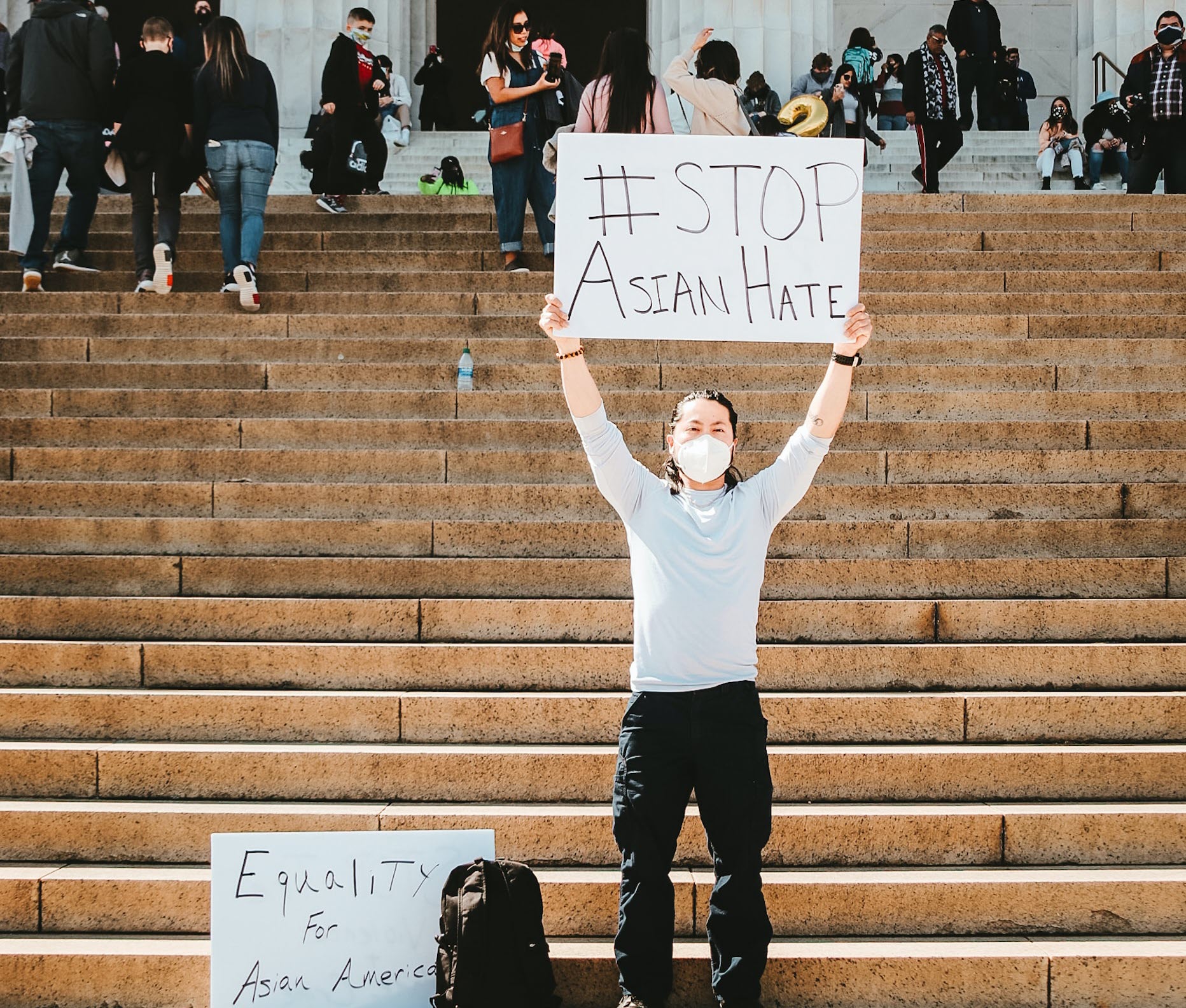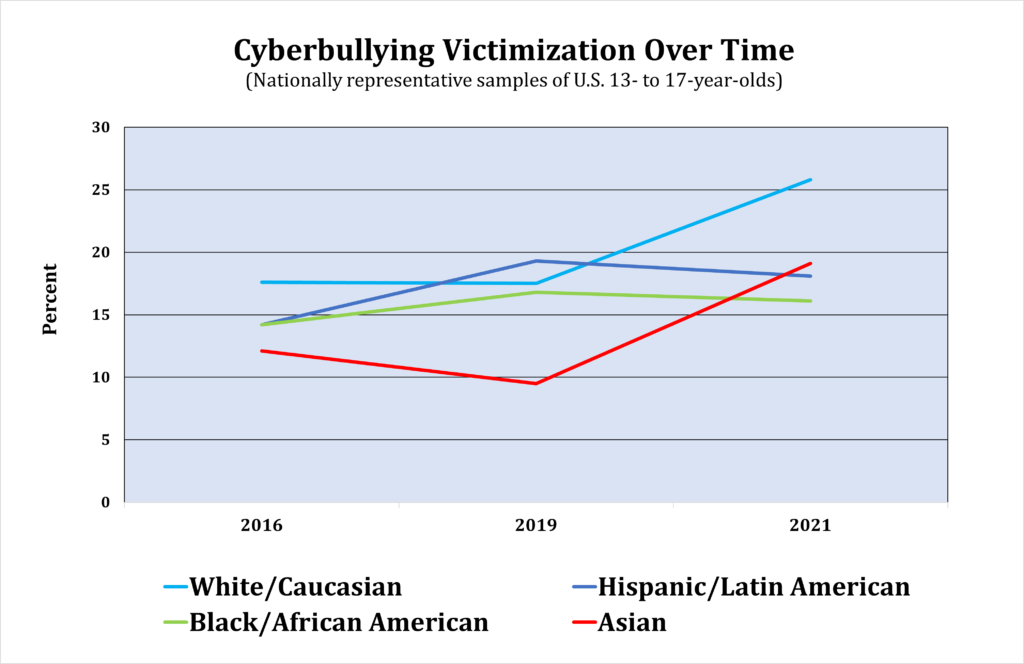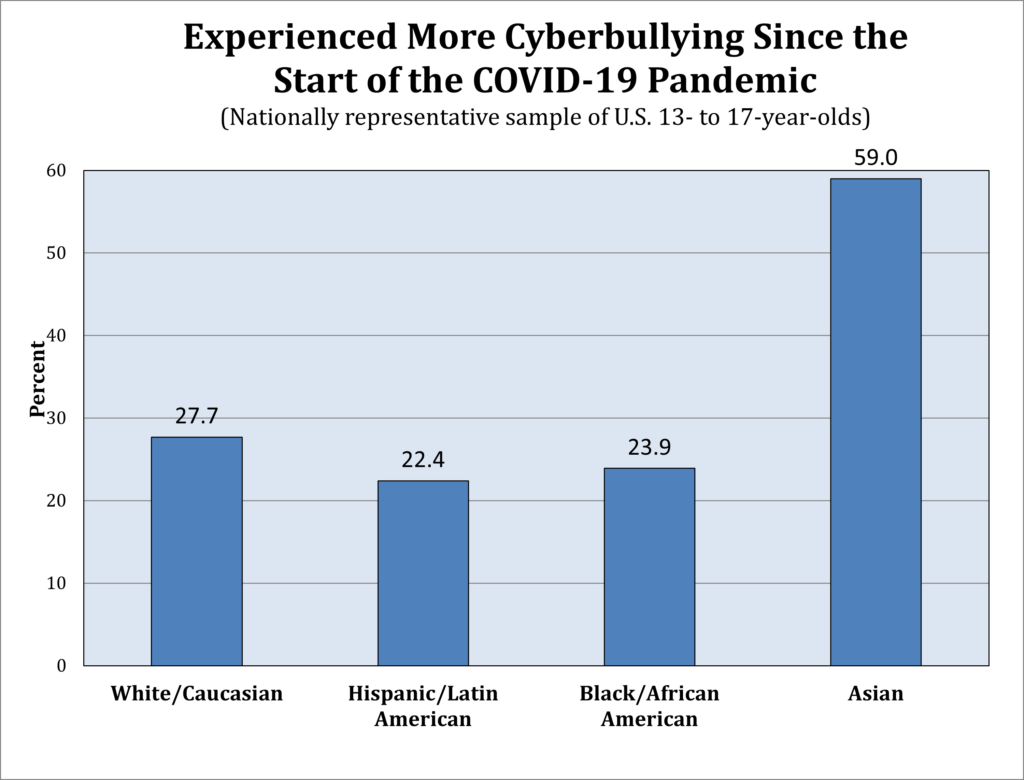
Last year I posted preliminary results of our inquiry into whether cyberbullying had increased during the COVID-19 pandemic. We found that it had in fact increased, though not to the extent that some had predicted. Today I can share that additional findings from this research have just been published in the Journal of School Health.
New Published Research
In this new paper, Sameer and I look more systematically at whether cyberbullying had increased during the COVID-19 pandemic, with a particular focus on the experiences of Asian American youth. Even before the pandemic began, there were troubling indications in the United States that political extremism was fomenting an us vs. them mentality that resulted in an increase in xenophobia and identity-based harassment. In the middle of this brewing firestorm, the politicization of the link between the COVID-19 virus and its presumed origination point (Wuhan, China), led to a pointed rise in anti-Chinese sentiment, but also a documented increase in harassment, bullying, and even personal and property victimization against Asian Americans. For example, a study published in Pediatrics found that 32% of Chinese American parents and 46% of their children reported experiencing COVID-19 related racial discrimination online.
Against this backdrop, we wanted to see if more Asian American youth had experienced cyberbullying since the start of the pandemic. We analyzed our three most recent national surveys of middle and high schoolers (conducted in 2016, 2019, and 2021), focusing on 13- to 17-year-olds. In each study, we asked about experience with cyberbullying generally, and whether youth had been targeted because of their race or color. In addition, the 2021 survey asked youth to tell us whether they had been cyberbullied more or less since the start of the COVID-19 pandemic.
Results
Overall, about 17% of all respondents reported that they had experienced cyberbullying within the last 30 days in both 2016 and 2019, compared to 23% in 2021. White/Caucasian and Asian youth saw significant increases from 2019 to 2021. In 2021, 25.8% of White/Caucasian youth said they were cyberbullied, compared to 17.5% in 2019. Likewise, in 2021, 19.1% of Asian youth were cyberbullied compared to 12.1% in 2019.
When focusing on cyberbullying specifically based on race or color, more youth also experienced this type of cyberbullying in 2021. In 2016 and 2019, about 10% of respondents said they had been cyberbullied because of their race or color compared to nearly 19% in 2021. Notably, Asian American youth saw the greatest increase in cyberbullying based on race or color between 2019 (7.4%) and 2021 (23.5%), though more youth from other races also said they were targeted because of their race from 2019 to 2021 (including White/Caucasian youth).
When asked whether students they had experienced more or less cyberbullying since the start of the COVID-19 pandemic, the majority of respondents from most racial groups said they had experienced less cyberbullying during that time. The notable exception was Asian American adolescents, among whom the majority (59%) reported that they had experienced more cyberbullying during the pandemic.
Summary
From the current analyses of middle- and high-schoolers in the United States, two major findings emerge. First, the prevalence of cyberbullying victimization in general increased since the beginning of the COVID-19 pandemic. Second, comparatively more Asian American youth said they experienced cyberbullying since the COVID-19 pandemic began. Additionally, Asian American youth were the only racial group where the majority (59%) reported more cyberbullying since the start of the COVID-19 pandemic.
The empirical evidence portraying an increase in Asian American victimization aligns with what has been found in other reports. While that finding was expected, it was surprising that youth from other racial backgrounds (including White/Caucasian youth) were also significantly more likely to have been cyberbullied because of their race in 2021 when compared to 2019. We pondered this for quite some time, and while we do not know which race(s) cyberbullied which race(s) (because it is often not possible to definitively determine this in online-only interactions), it is possible that some White youth reported they are being cyberbullied in 2021 because they were being subjected to counterspeech by others (e.g., targets and allies of any race). Counterspeech involves responding to hateful messages with the intention to de-escalate conflict, soften arguments, encourage civility, implicate the conscience, and shift norms of discourse. Some might view online retorts, particularly forceful ones responding to racially insensitive views, as a form of cyberbullying. We also suspect this finding may simply reflect an increase in online discord more generally, as people (youth and adults alike, from all racial backgrounds) continue to argue about broader social and political issues.
It will be interesting to see how these numbers evolve over time. We intent to collect more data next year to continue to track cyberbullying behaviors overall, and will of course pay special attention to whether there are any changes based on race. Perhaps the worst of the COVID-19 pandemic is behind us, but it—and its associated acrimonious social consequences—may linger for years to come.
The full paper can be downloaded here. If you don’t have access, just reach out and we’ll send you a copy.
Suggested citation: Patchin, J. W. & Hinduja, S. (2023). Cyberbullying Among Asian American Youth Before and During the COVID-19 Pandemic. Journal of School Health, 93, 82-87.
Photo from Viviana Rishe (unsplash)









